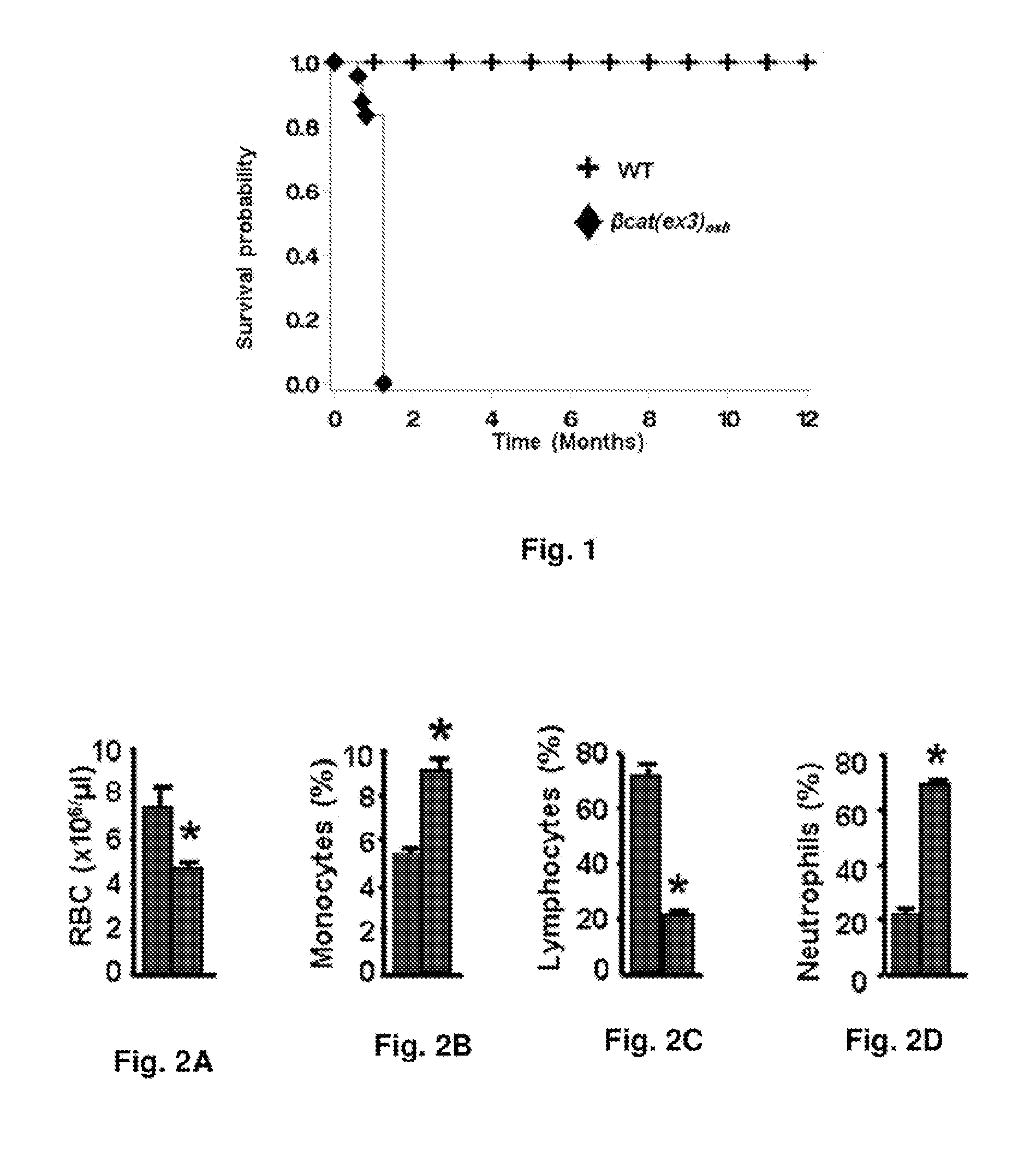Methods of treating, preventing and diagnosing leukemia and other blood diseases and disorders
- Summary
- Abstract
- Description
- Claims
- Application Information
AI Technical Summary
Benefits of technology
Problems solved by technology
Method used
Image
Examples
example 1
General Materials and Methods
Animals
[0263]Generation of FoxO1fl / fl, a1(I)Collagen-Cre [a1(I)Col-Cre], and Catnb+ / lox(ex3) mice has previously been reported (Paik et al., 2007; Dacquin et al., 2002; Harada et al., 1999; Rached et al., 2010a). Catnb+ / lox(ex3) mice, express a β-catenin mutant allele in which exon 3, encoding all serine and threonine residues phosphorylated by glycogen synthase kinase 3β (GSK-3β) (Logan and Nusse, 2004), is flanked by loxP sites.
[0264]Mice with osteoblast-specific constitute activation of β-catenin were generated by crossing Catnb+ / lox(ex3) mice with a1(I)Col-Cre mice expressing Cre under the control of 2.3 kb of the proximal promoter of the mouse pro-a1(I)Collagen gene. The transgene was expressed at high levels in osteoblasts specifically (Rossert et al., 1995). There was in no expression in chondrocytes, condensed mesenchymal cells, perichondrial or periosteal fibroblasts, or any other type I collagen-producing cells, or other fibroblast-rich tissues...
example 2
Activation of β-Catenin in Osteoblasts Causes Hematopoietic Dysfuntion
[0291]Using mice that express a constitutive active β-catenin allele in their osteoblasts, it was shown that this β-catenin activation causes hematopoietic dysfunction.
Materials and Methods
[0292]Mice that express a constitutive active β-catenin allele in their osteoblasts termed βcat(ex3)osb have been described previously by Glass et al. (2005) and are described in Example 1. These mice have an osteopetrotic phenotype because of a decrease in osteoclast numbers and die before 6 weeks of age (FIG. 1).
[0293]Hematological measurements, peripheral blood morphology, flow cytometry, PCR, and histological analysis were performed as described in Example 1.
Results
[0294]At 2 weeks of age, βcat(ex3)osb mice were anemic with a red blood cell count of 4.63±0.3×106 / μl as compared to a red blood cell count of 7.41±0.9×106 / μl in wild type mice (Table 2 and FIG. 2A). βcat(ex3)osb mice also had peripheral blood monocytosis, neutrop...
example 3
Further Evidence that Activation of β-Catenin in Osteoblasts Causes Hematopoietic Dysfuntion
[0297]The extensive hematopoietic abnormalities found in mice expressing the constitutive active β-catenin allele in their osteoblasts suggest the mutation affects multiple HSC lineages.
Materials and Methods
[0298]The same materials and methods were used as in Example 2.
Results
[0299]Because monocytes and granulocytes originate from the same progenitors, the hematopoietic stem and progenitor cell (HSPC) populations in the bone marrow were examined. The HSPC pool size, defined by Lin−Sca+c-Kit+ (LSK) cells, decreased 2-fold in βcat(ex3)osb mice, but their percentage was 2-fold greater than in wild type littermates (FIGS. 10A, 10B and 10C). The LSK+ / CD150+ / CD48− subset of long term repopulating HSC progenitors (LT-HSCs), increased both in numbers and percentage (FIGS. 10A, 10D and 10E). Activation of β-catenin was restricted to osteoblasts and was not affected in the LSK population of βcat(ex3)os...
PUM
| Property | Measurement | Unit |
|---|---|---|
| Electrical conductance | aaaaa | aaaaa |
Abstract
Description
Claims
Application Information
 Login to View More
Login to View More - R&D
- Intellectual Property
- Life Sciences
- Materials
- Tech Scout
- Unparalleled Data Quality
- Higher Quality Content
- 60% Fewer Hallucinations
Browse by: Latest US Patents, China's latest patents, Technical Efficacy Thesaurus, Application Domain, Technology Topic, Popular Technical Reports.
© 2025 PatSnap. All rights reserved.Legal|Privacy policy|Modern Slavery Act Transparency Statement|Sitemap|About US| Contact US: help@patsnap.com



